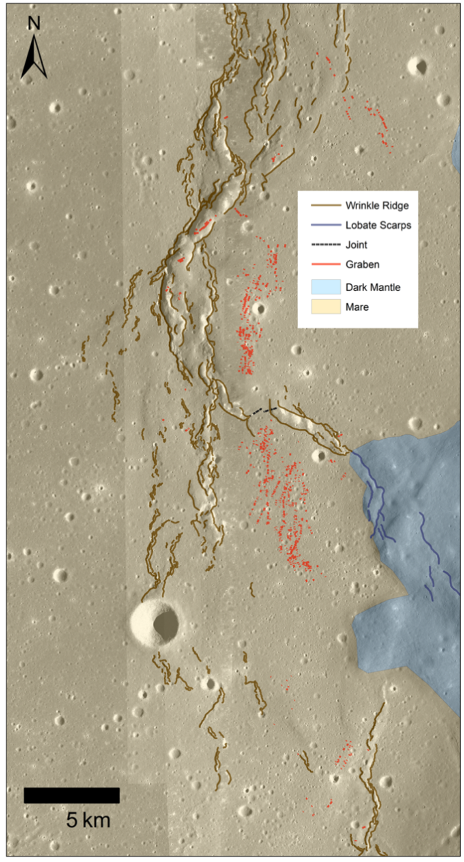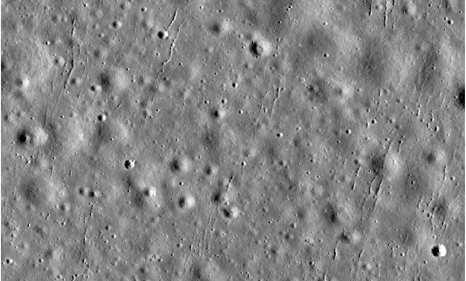Extensional Features at East Serenitatis Wrinkle Ridge-Lobate Scarp Transition Indicate Recent Tectonic Activity
- Arizona State University, School of Earth and Space Exploration, Tempe, United States of America (jclark@ser.asu.edu)
Introduction: The Moon exhibits globally dispersed tectonic landforms due to thermal contraction, solid-body tides, and loading of the crust. Wrinkle ridges and lobate scarps are both formed as a result of compressional stresses, however, their appearance and formation mechanisms are different [1-5]. Wrinkle ridges are interpreted as blind thrust faults, where horizontal shortening is accommodated by a fault that does not reach the surface. These faults are suggested to extend to depths between 100’s of meters to several kilometers [6-8]. It is thought that wrinkle ridges formed 0.1-0.65 Ga after basalt emplacement as a result of basin subsidence [6-11]. Lobate scarps on the other hand are among some of the youngest landforms on the Moon, with derived model ages < 700 Ma [12-16]. The faults that created the scarps are thought to offset the upper kilometer of the crust and are predominately in the highlands [15-16]. While wrinkle ridges and lobate scarps are typically not co-located, global mapping revealed at least nine cases where wrinkle ridges transition to lobate scarps at a mare-highland boundary [5,16-18]. These transitions are of interest as they are complex examples of recent tectonism [18-20].
The ridge-scarp transition in eastern Mare Serenitatis (21.7°N, 28.9°E) ruptures the surface at a contact between mare basalts and dark mantle deposits, approximately 70 km NW of the Apollo 17 landing site. The ridge is part of the southern section of the Dorsa Aldrovandi ridge system. Derived model ages for the mare units range from ~3 – 3.8 Ga [21], while the ridge-scarp transition has been active in the last 100 Ma [18]. Detailed mapping around both the ridges and scarp revealed a large network of small-scale graben. To better understand the relationship between the small extensional features and the compressional landforms, a geomorphologic map was produced as a first order investigation.
Data and Methods: We used NAC (Narrow Angle Camera; 1 m/pixel) image data from the Lunar Reconnaissance Orbiter Camera (LROC) with incidence angles of 60-75° for detailed geomorphological mapping [22]. The geomorphologic units and landforms were mapped on the basis of their morphology and albedo (Fig. 1). Wrinkle ridges, lobate scarps and small-scale graben are the mapped tectonic landforms as well as two volcanic units: dark mantle pyroclastic deposits and mare deposits. Impact craters were not included into the map.

Figure 1: Geomorphologic map of the wrinkle ridge-lobate scarp transition (white arrows) in eastern Mare Serenitatis (21.7°N, 28.9°E) on NAC image data. Brown lines are wrinkle ridge compound scarps, lobate scarps are mapped with blue lines, and small-scale graben are shown with red lines, dashed black lines are joints. Tan color represents the mare, while the light blue areas are dark mantle deposit
Geologic Interpretations (Fig 1.): The wrinkle ridges exhibit typical sinuous and braided morphology [10]. Many ridge sections are discontinuous with some segments as short as 1-2 km in length. The summits of the wider ridge segments occasionally host small-graben that are oriented along strike. Where the ridge crosses the mare-pyroclastic boundary the fault transforms into lobate scarp morphology, likely due to differences in substrate strength and or fault structure. Here, the scarps are simple, curvilinear landforms. The small graben (Fig. 2) are contained within the mare and are mostly tens of meters in length. Graben widths are only a few meters wide and either exhibit typical flat-floors bounded by an escarpment on both sides or v-shaped troughs with irregular edges.

Figure 2: Small-scale graben (21.7º, 28.7º) just south of the ridge section of the transition are approximately perpendicular to the fault.
A smaller ridge, which we tentatively mapped as a joint, traverses the gap (relay ramp) between two segments of the main wrinkle ridge complex and is perpendicular to the main wrinkle complex.
Discussion: Located around the compressional landforms are small-scale graben (Fig. 2). These graben are often found in other locations across the Moon and have been suggested to be the result of localized flexural bending or dilation from recent fault movement at compressional landforms, and are typically found in clusters of ≤20 [23, 24]. However, the graben here occur as a relatively large network (n=991) that spans over ~25 km and they likely formed as a secondary effect (extension) of recent tectonism in the ridges and scarps. These graben have a strong SSW-NNE orientation, which is roughly perpendicular to the section of the wrinkle ridge that transitions into a lobate scarp and parallel to the main Dorsa Aldrovandi ridge. Graben are also observed on the crests of the wrinkle ridges due to extension on the ridge and lateral extrusion of wedge material.
Conclusion: In addition to the late-Copernican ages determined for the wrinkle ridge-lobate scarp transition, the discovery of small-scale graben additionally suggests recent tectonism at the compressional landforms. This supports the hypothesis of a tectonically active Moon [5, 13, 19, 20, 24] that produces not just compressive, but also extensional landforms.
References: [1] Watters & Schultz (2010) Planetary Tectonics, Cambridge Univ. Press. [2] Schultz (1976) Moon Morphology, University of Texas Press. [3] Binder (1982) Earth, Moon, and Planets, 26. [4] Watters and Johnson (2010) Planetary Tectonics, Cambridge Univ. Press. [5] Watters et al. (2010) Science, 329. [6] Schultz (2000) JGR, 105, E5. [7] Solomon and Head (1979) JGR, 84. [8] Watters (1993) JGR-Planets, 98. [9] Solomon and Head (1980) Rev. Geophys. Space Phys., 18. [10] Plescia and Golombek (1986) GSA Bull., 97. [11] Yue et al. (2017) LPSC, #1926. [12] Binder and Gunga (1985) Icarus 63. [13] van der Bogert et al. (2018) Icarus 306. [14] Clark et al. (2015) LPSC, #1730. [15] Clark et al. (2016) LPSC, #1380. [16] Watters et al. (2015) Geology 43, 10. [17] Thompson et al. (2017) LPSC, #2665. [18] Clark et al (2019) LPSC, #2084 [19] Clark et al. (2017) LPSC, #1001. [20] Williams et al (2019) Icarus 326. [21] Hiesinger et al. (2000) JGR, 105. [22] Robinson et al. (2010) Space Sci. Rev. 150. [23] Watters et al (2012) Nature Geo. Sci. 5. [24] French et al (2015) Icarus 252.
How to cite: Clark, J. D., Bernhardt, H., and Robinson, M. S.: Extensional Features at East Serenitatis Wrinkle Ridge-Lobate Scarp Transition Indicate Recent Tectonic Activity, Europlanet Science Congress 2022, Granada, Spain, 18–23 Sep 2022, EPSC2022-757, https://doi.org/10.5194/epsc2022-757, 2022.

